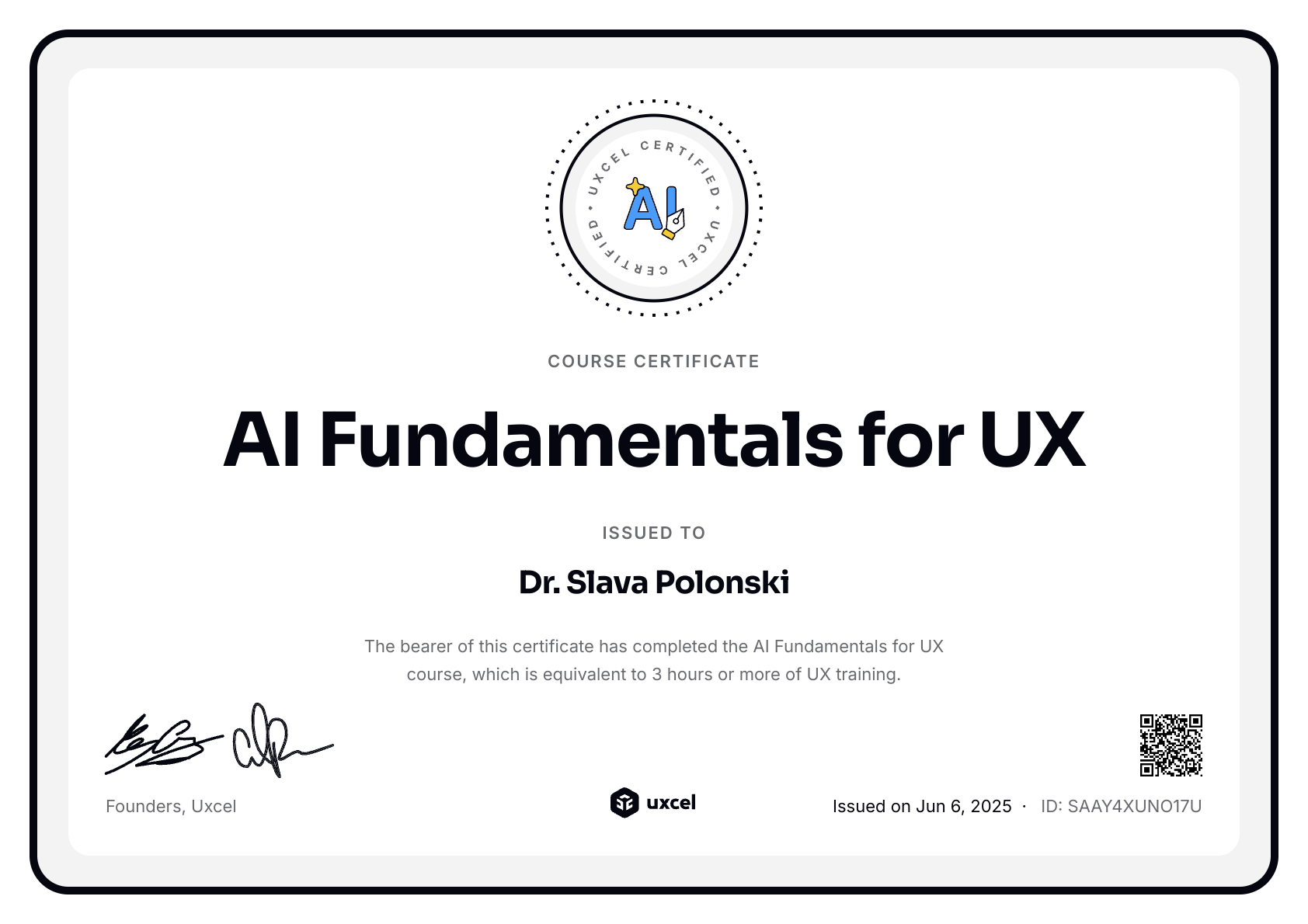AI Fundamentals for UX
Explore AI concepts, principles, and practices essential for creating human-centered, trustworthy AI-powered experiences.
About this course
AI is revolutionizing how digital products behave, making interfaces more adaptive, predictive, and personalized. This course equips UX designers with the foundational knowledge and practical skills needed to design effectively for AI-powered systems. You'll learn to distinguish AI-driven interfaces from traditional ones, understand AI capabilities and limitations, and apply human-centered principles to AI design.
Through four comprehensive levels, you'll explore mental models and ethical frameworks, craft interaction policies for AI, build user trust through transparency and control, and develop strategies for measuring success and governance. You'll analyze real-world case studies of AI UX successes and failures, practice designing feedback mechanisms, and learn to create frameworks for responsible AI products.
By course completion, you'll be prepared to collaborate effectively with data scientists, articulate model constraints, establish ethical guardrails, and design AI experiences that truly benefit users while mitigating risks.
Details
Prerequisites
Skills you’ll gain with course:
Topics covered
Syllabus
AI & UX Foundations




Level Test
User Expectations & Value




Level Test
Interaction Design & Trust




Level Test
User Control & Governance




Level Test
Earn a certificate of completion

Meet your course instructor

How does AI think—and how can we design for it? And what does “good UX” mean in an AI-first world?
I help people bridge the gap between human intuition and machine intelligence. Whether you're a UX designer curious about AI, or an AI builder who wants to get UX right, my work is all about making that intersection more human, more intentional, and more impactful.
Over the past 7 years at Google, I led user research for Flights and Hotels, diving deep into how people make decisions in complex, high-stakes moments. Along the way, I also contributed chapters and case studies to the People + AI Guidebook that Google launched in 2019.
I’ve taught these principles to UX designers at Spotify in New York, to fellow Googlers in Zurich, and at design conferences like IxDA in Milan. My goal is always the same: to help teams move beyond buzzwords and build AI products that actually work for people.
Stay tuned for my new UXcel course on the UX Fundamentals of AI—where design meets deep tech.
Loved by learners from world’s top companies












Related courses

Prioritization and Roadmapping

Business & Technical Fundamentals for PMs

AI Prompts Foundations
FAQs
As AI transforms digital products from simple tools into learning, adapting partners, designers need new skills to create experiences that truly benefit users. This course bridges the critical knowledge gap between traditional UX and AI-powered experiences.
The skills you'll learn are increasingly in demand across industries, as companies integrate AI capabilities into their products and services. While primarily designed for UX professionals, this course offers valuable insights for product managers who need to define AI feature requirements, developers who implement AI interfaces, content strategists crafting AI voice and personality, researchers studying AI interactions, and business leaders making strategic decisions about AI implementation. Even marketing professionals and customer experience specialists will benefit from understanding how AI transforms user journeys and touchpoints.
You'll gain practical frameworks and techniques to collaborate effectively with data scientists and engineering teams, advocate for user needs in AI development, design appropriate guardrails for AI behaviors, and create experiences that harness AI's potential while mitigating its inherent risks. These competencies will prepare you to lead design for next-generation AI products and help bridge communication gaps between technical and non-technical team members working on AI initiatives.
As AI transforms digital products from simple tools into learning, adapting partners, designers need new skills to create experiences that truly benefit users. This course bridges the critical knowledge gap between traditional UX and AI-powered experiences. The skills you'll learn are increasingly in demand across industries, as companies integrate AI capabilities into their products and services. You'll gain practical frameworks and techniques to collaborate effectively with data scientists and engineering teams, advocate for user needs in AI development, design appropriate guardrails for AI behaviors, and create experiences that harness AI's potential while mitigating its inherent risks. These competencies will prepare you to lead design for next-generation AI products.
Basic familiarity with UX design principles and common design patterns is recommended, but no technical AI or programming knowledge is required. We'll build that foundation together from scratch. If you understand concepts like user flows, mental models, and interface components, you're well-prepared to apply those frameworks to AI contexts. Some experience with digital product development will help you contextualize how AI transforms the design process, but it's not mandatory. The course introduces AI concepts in accessible, non-technical language specifically for designers. We focus on the implications for user experience rather than the mathematical or coding aspects of machine learning. If you've ever used AI-powered products like voice assistants, recommendation systems, or generative AI tools, your personal experience as a user will provide helpful context for understanding the design principles we'll explore.









